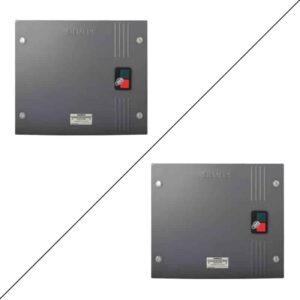Star Delta Starter
The are various methods to start an induction motor depending upon the number of terminals, phases, and horsepower (HP) or the motor in question.
These methods are mentioned below:
• Auto transfer starter
• Star Delta Starter
• Resistance Reduced Voltage Starter
• Increment Resistance starter
• Part Winding Reduced Voltage Starter
Meaning
Among the diverse options available, the most suitable and commonly used starting method is Star Delta Starter for an induction motor consisting of three phases. It’s the most popular and extensively utilized method. The following diagram depicts the connection of a Star-Delta Starter and an Induction Motor.
Star-Delta starter is used for the purpose of reducing the inflow of initial current entering the motor in order to diminish hindrances in the power supply. If the initial current flow is not reduced the outcome will be bad on other devices.
Function
The star-delta starter is a kind of three-phased reduced voltage starter since it’s employed to harness the earliest rush of current and diminish or eliminate torque.
Star Delta timer reduces the starting torque from the square of the voltage applied to induction motor to one third by direct delta starting.
The initial high current entering the induction motor could damage the machinery due to sudden high current flow. Using this method the motor is initially fed star and later while running, delta. It should be noted that in order to apply this method the motor should necessarily be delta connected during its normal run.
Components
1) Contactor:
A star-delta starter consists of 3 contractors.
• Main contactor
• Star contactor
• Delta contactor
A contactor is a durable electrically operated switch consisting of a set of input terminals and contact terminals with a high current rating, employed to power up the electrical motor. The current rating for contactors ranges from 10 amps to hundreds of amps. The high current contactor is composed of an alloy containing silver as its a good conductor.
Contrary to circuit breakers these contactors don’t suspend power flow and are accompanied by overload protection to turn up the motor. These are available in varied sizes for high current appliances.
2) Overload relay (OLR)
Overloading causes most of the winding fiasco.
OLR helps avoid the following conditions:
• Operation on unstable voltage supply or single phasing (by phase loss) leading to tremendous heating.
• Winding insulation depreciation necessitating defense against overload
• To protect from short circuit or internal winding fault of electric motor.
3) Timer
When approximately 90% of the maximum speed is attained, the timer functions to switch from star contactor to delta contactor in the starter.
4)Fuse unit
The motor is safeguarded against over current and/or short circuit by fuse unit.
It is made of an alloy possessing a low melting point in order to secure the motor in times of fault conditions. In such conditions, the conductor in the fuse melts due to excess temperature thereby breaking the circuit and restricting the flow of current.
Click here to buy a fuse unit.
5)MCB
It is a type of circuit breaker that is developed to safeguard an electrical circuit from vandalism caused by excess current due to overload/short circuits.
Its primary objective is to kill the flow of current following the fault.
MCB is used in the star delta starter motor circuit to safeguard the motor against fault conditions.
Click here to buy MCB.
6)Start push button (NO)
It is a normal push bottom which is normally set on open i.e. NO.
7) Stop push button (NC)
It is utilized to halt the motor and is an NC sort switch.
Working
• This is the reduced voltage starting method. Voltage reduction during star-delta starting is achieved by physically reconfiguring the motor windings.
• During starting, the motor windings are connected in a star configuration and this reduces the voltage across each winding. This also reduces the torque by an element of three.
• After a period of time the windings are reconfigured as delta and therefore the motor runs normally.
• Star-Delta starters are probably the most commonly used voltage starters.
• They’re utilized in an effort to scale down the beginning current applied to the motor during the start as a way of reducing the disturbances and interference on the electrical supply.
• The Star/Delta starter is manufactured from three contactors, a timer, and a thermal overload. The contractors are smaller than the only contactor utilized in Direct on Line starter as they’re controlling winding currents only.
• The currents through the winding are 1/√3 (58%) of the present within the line.
• Two contractors that are close during the run are the main contractors and are called delta contactors.
Types of Star-Delta Starters
• Simple Manual Star Delta Starter
• Manual Star Delta Starter with Push Button
• Semi-Automatic Star Delta Starter
• Automatic Star Delta Starter (open circuit)
• Automatic Star Delta Starter (closed circuit)
Advantages
• Simple starting method
• Can be utilized for squirrel-cage induction motor.
• Reduces the initial torque.
• Can be operated multiple times
• The initial current is reduced by a huge percentage.
• Also useful for the motor with six terminals.
• Low cost
• Easily available due to its popularity.
• Economical compared to soft starters or VDF
Disadvantages
• Initial torque is reduced by the amount with which initial current is reduced.
• For delta connection, the voltage supply should be similar to the rated motor.
• Motor with six terminals is required that to be delta connected.
• Transition from star contactor to delta contactor necessary resulting in peak transitions and high currents.
• It is only useful when the connected appliance is not heavily loaded in the beginning.
Best Brands are known for Star Delta Starters
L & T
ABB
In the absence of Star-Delta Starter
• Huge capacity circuit breakers would be mandatory to permit the flow of an initial surge current that doesn’t instantly shut off the motor.
• Considerably large-sized 3 phased power cables are necessary merely for starting time.
• Biggish coils are necessary and contacts on relays or contractors are required to control the motor and the normal running duration requires smaller sized coils.
• Instability in switching transient at times doesn’t allow huge motors to start in the absence of Star-Delta Starter.
 (+91) 7439 448 917
(+91) 7439 448 917 Cash on Delivery Available
Cash on Delivery Available



 Circuit Breakers
Circuit Breakers Power Distribution
Power Distribution Modular Switchboard
Modular Switchboard Wires & Cables
Wires & Cables







































